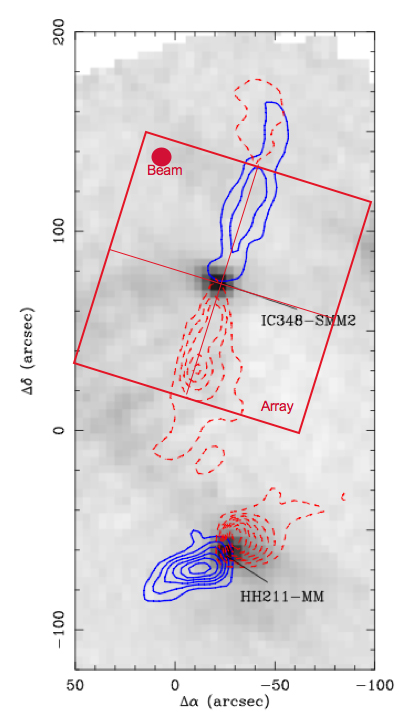
|
How SHARP Maps Galactic Magnetic Fields
|
||||
|
|
||||
|
A Key Investigation for SHARP: Testing Theoretical Models for Star Formation
|
||||
|
Many theories (but not all) invoke both angular momentum and magnetic fields to generate and collimate the outflows. Such theories generally assume that both the YSO rotation axis and the magnetic field direction within the infalling region are aligned with the outflow. The cartoon at right, taken from a 2006 paper by R. Crutcher in the journal "Science", shows the general picture assumed for magnetically-controlled collapse models of rotating YSOs. Such models result in small planet-forming disks surrounded by larger "pseudo-disks" that are shaped by the cloud magnetic field lines (shown in blue). |
 |
|||
|
A Survey of Young Stellar Objects with Collimated Outflows |
||||
| YSOs are typically found in small clusters, with outflow orientations that seem to be independent from one another. For example, the figure at right (from a 2006 paper by Tafalla, Kumar, and Bachiller) shows the dust thermal emission (greyscale) from the IC384-SW1 cloud, together with blue- and red-shifted emission lines from the CO molecule (contours). The two YSOs in this image have outflows pointing in very different directions. As discussed above, SHARP can map magnetic fields in a star forming cloud. The cartoon and observational map shown here illustrate the importance of spatial resolution. If we wish to test magnetically controlled collapse models such as are illustrated in the above cartoon, we should compare each outflow axis with the magnetic field lines immediately surrounding the corresponding YSO. Overlaid on the figure of the YSO IC348-SMM2 we show the sky region mapped by SHARP after one half-hour "dither" (box), and the area of one SHARP resolution element (filled circle). This comparison shows that SHARP's capabilities are well suited to the task of confirming or disproving the magnetic field geometry illustrated in the cartoon. We have initiated a SHARP survey of relatively nearby YSOs having well-defined outflows oriented close to the plane of the sky. For these targets, SHARP's resolution is comparable to the pseudodisk size. Initial results have been reported in two papers (Davidson et al. 2011 and Chapman et al. submitted; for full references click here). These papers present polarization results for L1527, B335, IC348-SMM2, L1448-IRS2, L483, Serp-FIR1, and L1157. Other survey YSOs are L1551-NE, HH211-MM, IRAS 03282, B1-c, and CB 68. |
 |
|||